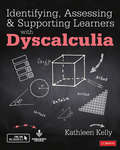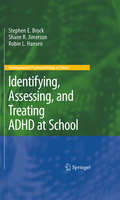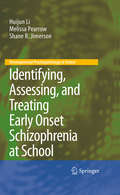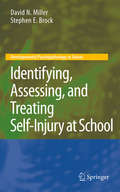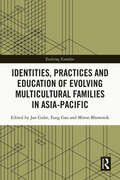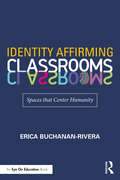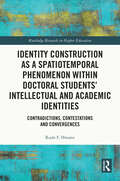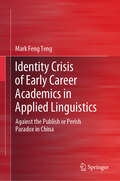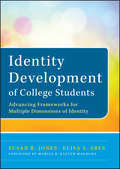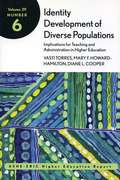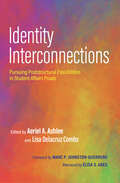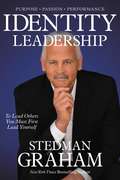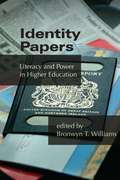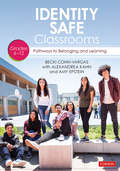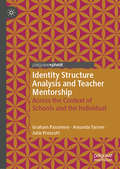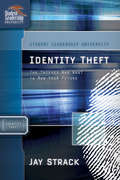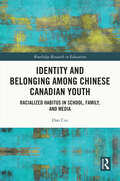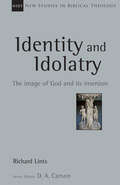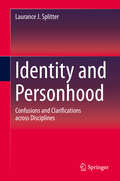- Table View
- List View
Identifying, Assessing and Supporting Learners with Dyscalculia (Corwin Ltd)
by Kathleen Kelly***** Online Resources are open access. No code is required ***** It is vital to understand the challenges and provide the right support for learners with dyscalculia and specific learning difficulties in mathematics. The book provides: • an overview of current research explaining the nature and causation of dyscalculia • guidance on the identification of dyscalculia • examples of how to carry out informal and formal assessments • an explanation of the principles of multisensory mathematics teaching • an outline of a structured programme (for learners aged 5-14), together with examples of lesson planning and activities. Designed for teachers specialising in the assessment and teaching of learners with dyscalculia, and those undertaking courses leading to Approved Teacher Dyscalculia (ATD) and Associate Membership of the British Dyslexia Association (AMBDA), the book is useful to any professional looking for an understanding of this area of specific difficulty.
Identifying, Assessing and Supporting Learners with Dyscalculia (Corwin Ltd)
by Kathleen Kelly***** Online Resources are open access. No code is required ***** It is vital to understand the challenges and provide the right support for learners with dyscalculia and specific learning difficulties in mathematics. The book provides: • an overview of current research explaining the nature and causation of dyscalculia • guidance on the identification of dyscalculia • examples of how to carry out informal and formal assessments • an explanation of the principles of multisensory mathematics teaching • an outline of a structured programme (for learners aged 5-14), together with examples of lesson planning and activities. Designed for teachers specialising in the assessment and teaching of learners with dyscalculia, and those undertaking courses leading to Approved Teacher Dyscalculia (ATD) and Associate Membership of the British Dyslexia Association (AMBDA), the book is useful to any professional looking for an understanding of this area of specific difficulty.
Identifying, Assessing, and Treating ADHD at School
by Stephen E. Brock Robin L. Hansen Shane R. JimersonADHD is the most commonly diagnosed childhood behavioral disorder. Moreover, many students receiving special education assistance are reported to have ADHD. Children with ADHD may experience significant school adjustment difficulties and achievement problems. Problem behaviors associated with attention deficits and hyperactivity often have a negative impact on the classroom, and, therefore, may compromise the learning environment for many, if not all, students. There is a critical need for school professionals to identify, assess, and treat students with ADHD. Identifying, Assessing, and Treating ADHD at School brings science to practice, providing school professionals invaluable information to meet the needs of children with ADHD. This volume, designed as a practical, easy-to-use reference for school psychologists and other mental health and educational professionals: Explains why school psychologists and their colleagues need to be prepared and able to identify and serve students with ADHD. Identifies the prevalence, influences, and associated conditions. Provides a review of screening, referral, and diagnostic assessment processes. Offers guidance on conducting psychoeducational assessments. Reviews evidence-based treatments. Offers practical guidance on setting up programs that address individual and classroom issues. School psychologists and other education and mental health professionals will find Identifying, Assessing, and Treating ADHD at School an exceptional resource in working to enhance the mental health and academic development of students.
Identifying, Assessing, and Treating Bipolar Disorder at School
by Stephen E. Brock Shelley R. Hart Ida JeltovaIdentifying, Assessing, and Treating Bipolar Disorder at School presents child and education practitioners with an evidence-based framework for accurate identification, assessment, and intervention of bipolar disorder. This straightforward resource clears up misconceptions about the condition, and outlines its complex presentation in young people, where it may appear in tandem with other disorders and bring challenges to treatment. By providing information to assist in referrals, consultations, and recommendations for special education, the authors give the reader a unique vantage point for improving students' learning environment and helping to facilitate the work of fellow professionals. Among the topics: Prevalence and associated conditions. Case finding, screening, and referrals. Diagnostic and psycho-educational assessment Treatment of bipolar disorder in children and adolescents. Plus suggested resources to assist students and their families. Identifying, Assessing, and Treating Bipolar Disorder at School is an essential reference for school psychologists and allied educational professionals, special education teachers, speech and language therapists, counselors, clinical child psychologists, and mental health practitioners.
Identifying, Assessing, and Treating Dyslexia at School
by John M. Davis Catherine Christo Stephen E. BrockAs many as one in four children experiences problems with reading. Dyslexia, the most common learning disability leads to well-documented negative effects on school and, ultimately, adult success. Therefore, it is critical that school professionals provide early and effective assessment and intervention. Identifying, Assessing, and Treating Dyslexia at School equips practitioners with in-depth understanding of the disorder and a wealth of practical information for meeting student needs. This volume: Reviews up-to-date findings on dyslexia - causes, prevalence, and related conditions. Provides research-based tools for identifying and addressing dyslexia. Offers a detailed framework for case finding and screening, diagnostic and psychoeducational assessment as well as age- and grade-appropriate intervention. Explains the roles and responsibilities of school psychologists when it comes to identifying students with dyslexia. Focuses solely on dyslexia, unlike most other books on learning disabilities. As the duties of school psychologists and related education professionals become more complex, recognizing and providing services for students with learning disorders has become progressively more demanding. Identifying, Assessing, and Treating Dyslexia at School offers practitioners an accessible and easy-to-read reference that they will use for years to come.
Identifying, Assessing, and Treating Early Onset Schizophrenia at School
by Shane R. Jimerson Melissa Pearrow Huijun LiBy itself or in combination with an affective disorder, early onset schizophrenia (EOS) -- the onset of symptoms before 18 years of age -- can create severe deficits in young people's academic performance, family and peer relationships, and even the ability to acquire new skills. The relative rarity of the condition, meanwhile, can leave school personnel unsure of how to meet -- or even recognize -- student needs. Identifying, Assessing, and Treating Early Onset Schizophrenia at School emphasizes the importance of providing teachers and students alike with the support needed to enhance academic performance and improve social skills of children and adolescents with EOS within educational settings. In addition, its evidence-based framework enables school professionals to achieve greater confidence and accuracy in identifying students with EOS and provide appropriate services, both in special education and general classes. In this authoritative and accessible volume, experts offer the most salient information on early onset schizophrenia, including: Contributing factors and risk factors.Prevalence and epidemiology.Screening and assessment procedures.Guidelines for determining eligibility for special education programs under IDEIA and Section 504.Latest findings on school-based and off-campus interventions for EOS.A useful resource appendix.Identifying, Assessing, and Treating Early Onset Schizophrenia at School gives school psychologists and allied education professionals both a practical understanding of this disabling condition and the most up-to-date strategies for providing earlier and effective interventions.
Identifying, Assessing, and Treating Self-Injury at School
by Stephen E. Brock David N. MillerNonsuicidal self-injury (NSSI) among young people--most notably in the form of forearm- or wrist-cutting--occurs across cultural groups, social strata, and developmental stages, puzzling and repelling adults. Youth engaging in NSSI behaviors are at a higher risk for suicidality as well as other mental health and academic problems. And because NSSI is often first noticed in the school setting (as is the case with many children's disorders), school professionals are being encouraged to take a more proactive role in intervention. The first book specifically geared toward education personnel, Identifying, Assessing, and Treating Self-Injury at School clearly defines NSSI, differentiating it from suicidal, borderline, and other behaviors and analyzing the psychological contexts in which it occurs. This school-based perspective gives readers a practical framework for earlier, more accurate diagnosis; relevant consulting with parents, teachers, and colleagues; and effective, science-based treatment. Included in the coverage: an overview of causes of self-injury, current findings on prevalence and associated conditions, early screening guidelines, including risk factors and warning signs, the latest information on assessment issues and diagnostic methods, a separate chapter on psychoeducational assessment and up-to-date research on interventions for NSSI. Identifying, Assessing, and Treating Self-Injury at School offers a solid foundation for school psychologists and allied educational professionals to understand students with NSSI and address their complex needs.
Identities, Practices and Education of Evolving Multicultural Families in Asia-Pacific (Evolving Families)
by Jan GubeThis edited book highlights the identities and practices of ethnically diverse families and schools in contexts where multicultural policies are not always a priority. In an era of globalization and ensuing population mobility, it places a focus on Asia-Pacific, a continent with diverse customs, populations, and languages, but grapples with what it might mean to be multicultural. The book features studies and frameworks that illustrate how minoritized communities engage with the diversity they live in and strategies in adjusting and adapting to their sociocultural environments, including practices that might support these efforts. This book represents initiatives and interdisciplinary scholarship from Japan, Hong Kong, mainland China, Australia, South Korea, Thailand, and Taiwan, which underscore the intersection of identities, cultural values, efforts, conflicts, and religions in making diversity work in their contexts. Collectively, these works make a unique contribution by invigorating debates on the flows and evolvement of cultural values and practices within and across families and institutions. This book will appeal to researchers, practitioners, and readers with interest in the current state of cultural diversity among minoritized families in Asia-Pacific and beyond.
Identity Affirming Classrooms: Spaces that Center Humanity
by Erica Buchanan-RiveraLearn how to create identity affirming classroom environments that honor the humanity of students. Although schools have potential to be spaces of inquiry and joy, they can also be the source of trauma and pain when educational equity is not a foundational element. With a race-conscious lens, Dr. Erica Buchanan-Rivera explains how to actively listen to the voices of students and act in response to their needs in order to truly activate equity and make conditions conducive for learning. She also offers insights on how we need to do anti-bias and antiracist work in efforts to create affirming, brave spaces. Throughout the book, you’ll find features such as Mirror Work and Collective Work to help you bring the ideas to your own practice and discuss them with others. You’ll also find excerpts from students' voices to hear the why behind affirming spaces through their perspectives. With the powerful ideas in this book, you’ll be able to create the kinds of classroom environments that students deserve.
Identity Construction as a Spatiotemporal Phenomenon within Doctoral Students' Intellectual and Academic Identities: Contradictions, Contestations and Convergences (Routledge Research in Higher Education)
by Rudo F. HwamiInvestigating the interplay between space, time and identity construction, this book brings to focus how spatiality and temporality have been largely overlooked in the study and theorisation of identity construction.Offering Gloria Anzaldúa concept of ‘conocimento’ as a theoretical tool for analysing identity construction, the book investigates how doctoral students hold varying assumptions about their intellectual identity, where the doctoral process enables them to deconstruct and reconstruct these identities. Chapters examine the implications for scholars who find themselves in the in-between space of transitional identities, advocating the need for innovative identity theorisation to strike a balance in the shifting dynamics between different presentations of identity and belief systems. Bringing together Lefebvre’s theorisation of the relationship between space and the body in rhythmanalysis and Anzaldua’s theorisation of the relationship between the body and identity construction, the book offers a transdisciplinary reading of space, body, and identity.Providing a space to continue and progress the foregrounding of narratives from marginalised voices and groups in higher education, the book will be of interest to scholars, researchers and academics in the fields of sociology of education, multicultural education, higher education, and philosophy of education.
Identity Crisis of Early Career Academics in Applied Linguistics: Against the Publish or Perish Paradox in China
by Mark Feng TengThis book adopts a tripartite framework approach to explore the identity construction of early-career researchers in applied linguistics. This tripartite framework of identity-in-practice, identity-in-discourse, and identity-in-activity enables a comprehensive understanding of the complexities involved in the process, within the context of China's higher education context. By delving into the complexities of early-career teachers' professional development and identity construction in China's evolving higher education landscape, readers gain a deeper understanding of the challenges and opportunities faced by these professionals. This knowledge informs educators and administrators in providing effective support for the professional development of early-career teachers, as well as offers insights that may be applicable to teachers and researchers in other contexts. Furthermore, the tripartite framework of teacher identity based on the findings lends support to an expanded notion of professional development that higher education teachers should draw on to empower themselves.
Identity Development of College Students
by MARCIA B. BAXTER MAGOLDA Susan R. Jones Elisa S. AbesThis book describes contemporary perspectives on the identity development of college students in the U.S. with an emphasis on multiple social identities. The book traces the evolution of the study of identity in relation to contemporary research and theoretical frameworks. These contemporary perspectives are situated within a holistic description of identity that portrays identity as the intersection of context, personal characteristics, and social identities. It explores the nature of context, including inequitable power structures, and how context influences and is influenced by multiple social identities. The authors use research on multiple identities as a springboard, including using critical theoretical frameworks to analyze these relationships, such as intersectionality, critical race theory, and queer theory.
Identity Development of Diverse Populations
by Vasti Torres Mary F. Howard-Hamilton Diane L. CooperThis monograph is focused on educating faculty and administrators about the developmental issues faced by students from different racial, ethnic, or other social groupings as they attempt to define themselves during the college years and the ways this information can enhance campus classrooms, programs, and policies. Although there is a growing body of work on how various racial, ethnic, gender and other social groups develop their identity, there has been limited synthesis or application of this literature to the practice of professionals in higher education. The authors have higher education administrative backgrounds, so their recommendations are grounded in experience, and each also has a solid record of scholarship in identity development. The combined scholarly and administrative experience of the three authors enhances the contribution of this book.
Identity Interconnections: Pursuing Poststructural Possibilities in Student Affairs Praxis
by Lisa Delacruz Combs Aeriel A. AshleeCo-published with This book advocates an approach the authors call Identity Interconnections as a way of moving considerations of identity differences and commonalities from theory to socially just action in student affairs practice.Through pursuing complex commonalities expansive enough to hold both similarities and differences, student affairs educators can ethically consider identity interconnections in such a way that does not diminish difference, but instead recognizes points of difference as opportunities for social justice action. By pursuing radical interconnectivity, student affairs educators can advance an interdependent understanding of inherited systems of power; recognizing the ways in which all systems (and thus all oppression, and all liberation) are interconnected. This interconnected insight can enable student affairs educators to extend beyond binary and oppositional thinking, and in turn, give rise to the formation of new coalitions. Finally, by listening with raw openness (allowing themselves, and encouraging their students, to be changed by others’ experiences), student affairs educators can facilitate identity development and social justice action as interrelated endeavors.The editors have heard comments like, “This is all great in theory, but how can student affairs practitioners actually apply this?” This book answers that question by providing a theoretical framework and multiple practical examples for employing identity interconnections as expansive approaches to identity development and social justice action in student affairs.
Identity Leadership: To Lead Others You Must First Lead Yourself
by Stedman GrahamBecome a passionate, purposeful, and meaningful leader through identifying who you are, your strengths, and your skills. New York Times bestselling author Stedman Graham's Identity Leadership is a very personal and prescriptive guide that is based on his philosophy that a leader can't lead others until he can first lead himself-the more he works on himself, the more he can give to those around him. To know our purpose in life, we begin with our passions, skills, and talents, and with this book we learn how to channel the best of who we are to achieve success for ourselves and those we lead. In Identity Leadership, Graham examines why self-awareness matters, how leaders lead, the importance of communication, and much more. He then shows the reader how to step into their role as a leader and create their identity leadership plan. Key to the journey is believing in yourself, knowing your competence, continually challenging yourself, and being patient with yourself. Graham uses anecdotes from his own life, as well as discussing successful leaders, to illustrate the importance of identity leadership in each of our lives.Self-leaders can create a roadmap that leads to personal growth, development, and improvement of performance in every area of life. Identity Leadership provides the tools-self-awareness, emotional intelligence, discipline, and more-needed to continually plan and execute learning and development of our talents and skills. These tools enable readers to commit to a personal vision and lead with purpose. p.p1 {margin: 0.0px 0.0px 0.0px 0.0px; font: 12.0px Helvetica} p.p2 {margin: 0.0px 0.0px 0.0px 0.0px; font: 12.0px Helvetica; min-height: 14.0px} span.s1 {background-color: #fffb00} p.p1 {margin: 0.0px 0.0px 0.0px 0.0px; font: 12.0px Helvetica} p.p2 {margin: 0.0px 0.0px 0.0px 0.0px; font: 12.0px Helvetica; min-height: 14.0px} span.s1 {background-color: #fffb00} p.p1 {margin: 0.0px 0.0px 0.0px 0.0px; font: 12.0px Helvetica} p.p2 {margin: 0.0px 0.0px 0.0px 0.0px; font: 12.0px Helvetica; min-height: 14.0px} span.s1 {background-color: #fffb00}
Identity Papers: Literacy and Power in Higher Education
by Bronwyn T. WilliamsHow do definitions of literacy in the academy, and the pedagogies that reinforce such definitions, influence and shape our identities as teachers, scholars, and students? The contributors gathered here reflect on those moments when the dominant cultural and institutional definitions of our identities conflict with our other identities, shaped by class, race, gender, sexual orientation, location, or other cultural factors. These writers explore the struggle, identify the sources of conflict, and discuss how they respond personally to such tensions in their scholarship, teaching, and administration. They also illustrate how writing helps them and their students compose alternative identities that may allow the connection of professional identities with internal desires and senses of self. They emphasize how identity comes into play in education and literacy and how institutional and cultural power is reinforced in the pedagogies and values of the writing classroom and writing profession.
Identity Safe Classrooms, Grades 6-12: Pathways to Belonging and Learning
by Amy Epstein Becki Cohn-Vargas Alexandrea Creer KahnWelcome to Identity Safe Classrooms! In identify safe classrooms, students facing negative stereotypes or viewed as different are &“seen,&” accepted, and valued for who and what they are. Their identity is embraced as an asset not a barrier for school success. Identity safety is a research-based set of practices that counter the harmful effects of stereotype threat and allow our students to reach their full capacity for learning, foster positive relationships, and better appreciate the full spectrum of human differences. The second of a two-volume set, Identity Safe Classrooms, Grades 6-12, is a call for educators to come together and realize a vision of schools as transformative places of opportunity and equity for all students. Inside you&’ll find: Design principles for promoting belonging and a welcoming classroom environment Compelling evidence from identity safety research on ways to mitigate stereotype threat along with counter-narratives that challenge societal biases about gender, race, and other differences Pragmatic strategies for student-centered teaching, including trauma-informed practices, that hold high expectations and validate each student&’s background as a resource for learning Vignettes with concrete examples and try-it-out activities and prompts for self-reflection Devour Identity Safe Classrooms, adopt its practices, and soon enough you&’ll inspire in all of your students a greater sense of empathy and agency in their educational experiences. &“Dr. Becki Cohn-Vargas along with Alexandrea Creer Kahn and Amy Epstein show us the intersections between adolescent identity development, racial identity development, and social-emotional development so we know how to use the diversity in classrooms as our strength.&” --Zaretta Hammond, Author of Culturally Responsive Teaching and the Brain &“Identity Safe Classrooms should be in the hands of every educator who walks into a school. It's clear and accessible, grounded in research, thought-provoking and engaging, and actionable, and fills a crucial gap in our resources for creating just and liberated schools.&” --Elena Aguilar, Author of The Art of Coaching &“The authors have done an excellent job showing how an identity safe classroom integrates the growth mindset in a secondary school. When students feel accepted and valued, when they feel safe learning from mistakes and encouraged to continually grow as learners, they can reach their highest potential.&” --Carol Dweck, Stanford University
Identity Safe Classrooms, Grades 6-12: Pathways to Belonging and Learning
by Amy Epstein Becki Cohn-Vargas Alexandrea Creer KahnWelcome to Identity Safe Classrooms! In identify safe classrooms, students facing negative stereotypes or viewed as different are &“seen,&” accepted, and valued for who and what they are. Their identity is embraced as an asset not a barrier for school success. Identity safety is a research-based set of practices that counter the harmful effects of stereotype threat and allow our students to reach their full capacity for learning, foster positive relationships, and better appreciate the full spectrum of human differences. The second of a two-volume set, Identity Safe Classrooms, Grades 6-12, is a call for educators to come together and realize a vision of schools as transformative places of opportunity and equity for all students. Inside you&’ll find: Design principles for promoting belonging and a welcoming classroom environment Compelling evidence from identity safety research on ways to mitigate stereotype threat along with counter-narratives that challenge societal biases about gender, race, and other differences Pragmatic strategies for student-centered teaching, including trauma-informed practices, that hold high expectations and validate each student&’s background as a resource for learning Vignettes with concrete examples and try-it-out activities and prompts for self-reflection Devour Identity Safe Classrooms, adopt its practices, and soon enough you&’ll inspire in all of your students a greater sense of empathy and agency in their educational experiences. &“Dr. Becki Cohn-Vargas along with Alexandrea Creer Kahn and Amy Epstein show us the intersections between adolescent identity development, racial identity development, and social-emotional development so we know how to use the diversity in classrooms as our strength.&” --Zaretta Hammond, Author of Culturally Responsive Teaching and the Brain &“Identity Safe Classrooms should be in the hands of every educator who walks into a school. It's clear and accessible, grounded in research, thought-provoking and engaging, and actionable, and fills a crucial gap in our resources for creating just and liberated schools.&” --Elena Aguilar, Author of The Art of Coaching &“The authors have done an excellent job showing how an identity safe classroom integrates the growth mindset in a secondary school. When students feel accepted and valued, when they feel safe learning from mistakes and encouraged to continually grow as learners, they can reach their highest potential.&” --Carol Dweck, Stanford University
Identity Safe Classrooms: Places to Belong and Learn
by Becki Cohn-Vargas Dorothy M. SteeleEvery child valued and empowered to learn—this book shows you how! <p><p> This book focuses on strategies that positively affect student learning and attachment to schooling, in spite of social inequalities. Research shows that students in identity safe classrooms learn better and like school more than peers in other classrooms. In identity safe classrooms, teachers strive to ensure that students: <p> Feel their identity is an asset rather than a barrier to success <p> Experience diversity as a resource for learning <p> Form positive relationships with fellow students and their teacher <p> Learn in an environment with a challenging curriculum and high expectations <p> Develop a sense of belonging and empathy for others as they learn to use pro-social skills and practice cooperation
Identity Structure Analysis and Teacher Mentorship: Across the Context of Schools and the Individual
by Graham Passmore Amanda Turner Julie PrescottThis book examines the benefits of applying the Identity Structure Analysis (ISA) to teacher professional development. At present no government, local authority or school is actively applying Identity Structure Analysis to monitor school improvement: in a profession where turnover is extremely high, ISA is framed as a way for professional development to meet the needs of the specific teacher. Examining idiographic ISA analyses as well as practical advice for implementing professional development programs, the authors scrutinise how ISA can be used in conjunction with mentoring to offset teacher turnover. This practical volume will be of interest and value to scholars and researchers of teacher identity and professional development, as well as researchers and policymakers interested in reducing teacher turnover.
Identity Theft: The Thieves Who Want to Rob Your Future (Student Leadership University Study Guide)
by Jay StrackFor over 20 years, Dr. Jay Strack has been working with young Christian leaders throughout the U.S. and teaching them have a better understanding of God's Word and His calling in their lives. The topics chosen for the Student Leadership University Study Guide Series represent part of the teaching model that Dr. Strack has developed over the years and address tough questions that young people are asking today.In Identity Theft: What Every Student Needs to Watch Out For, Dr. Strack encourages students to not lose their identity in Christ as they journey from adolescence to adulthood. Chapter titles include:Watch Where You Hang: Peer Pressure and the CrowdI Can't Remember What I Did: The Behavior Driven by Alcohol and DrugsToo Many Mistakes--I Give Up: Robbed by the PastToo Ashamed to Tell: Sexual Experiences and ExperimentsNot Me-I'm Too Dumb: Lack of Self-ConfidenceClub Chameleon: Changing Who You Are to Fit InIt's Not My Fault: The Self-Destruction of Excuse LandPharisees and Other Self-Help Groups: When Life is Just Rules and No Joy
Identity and Belonging Among Chinese Canadian Youth: Racialized Habitus in School, Family, and Media (Routledge Research in Education)
by Dan CuiIdentity and Belonging amongst Chinese Canadian Youth unveils how Chinese immigrant youth struggle as racialized minorities at school, within family and through their formative interactions with Canadian mainstream media. Utilizing rich interview data, the author explores how the contemporary forms of racism, multiculturalism, immigration and transnationalism affect the identity construction of second-generation Chinese immigrant youth in Canada, as well as their negotiation of belonging at social institutions through schools and mainstream media in Canada. The text systematically examines the lived experiences and perceptions of Chinese immigrant youth in relation to race, ethnicity, and class. Uniquely extending Bourdieu’s concept of habitus to race and ethnicity, the author traces issues of racism and “model minority” discourses not only to systemic and institutional origins, but to internalized individual ways of thinking, doing, and being. This book will appeal to academics and scholars tracing racial inequality through the multiplicity of Asian diasporas existing in the western societies, as well as researchers seeking new understandings of modern-day media, and with interests in multicultural education, the sociology of education, and theories of race and ethnicity.
Identity and Idolatry: The Image of God and Its Inversion (New Studies in Biblical Theology #Volume 36)
by Richard LintsOne of Desiring God's Top 15 Books"So God created man in his own image, in the image of God he created him; male and female he created them." (Genesis 1:27)Genesis 1:26-27 has served as the locus of most theological anthropologies in the central Christian tradition. However, Richard Lints observes that too rarely have these verses been understood as conceptually interwoven with the whole of the prologue materials of Genesis 1. The construction of the cosmic temple strongly hints that the "image of God" language serves liturgical functions.imageimago DeiIn the concluding chapters of this New Studies in Biblical Theology volume, Lints interprets the use of idolatry as it emerges in the secular prophets of the nineteenth century, and examines the recent renaissance of interest in idolatry with its conceptual power to explain the "culture of desire."Addressing key issues in biblical theology, the works comprising New Studies in Biblical Theology are creative attempts to help Christians better understand their Bibles. The NSBT series is edited by D. A. Carson, aiming to simultaneously instruct and to edify, to interact with current scholarship and to point the way ahead.
Identity and Personhood
by Laurance J. SplitterThis book approaches the concept of identity from both logical-linguistic and socio-cultural perspectives, and explores its implications for our understanding of who or what we persons really are. In the process, it bridges disciplines that often remain disconnected - most notably analytic philosophy and the social sciences - and offers a novel critique of citizenship and moral education, "identity politics", and other contemporary domains of inquiry. Although the book has a multi-disciplinary focus, it is philosophical in its overall orientation (but accessible to readers from outside philosophy) and educational in its mission (but of interest to readers who are not formally educators). Chapters 2-5 discuss the philosophical and (where appropriate) scientific dimensions of identity, chapters 6-7 explore its socio-cultural dimensions and chapter 8 examines its educational dimensions and implications. The book will be of particular interest to those researching or teaching civics, citizenship education and moral education, as well as those involved in cultural, political and religious studies in a broader sense. It will also appeal to anyone who finds him- or herself wondering about the state of the world in the Twenty-First Century, and who suspects that rethinking what it means to be a person in that world might not be a bad idea.
Identity and Resistance in Further Education (Routledge Research in Vocational Education)
by Rob Smith Pete BennettIn recent years, Further Education has reached a crossroads, with questions being asked about its function, aims and focus, as well as querying the role of the FE teacher, the key aspects of the curriculum and which values should inform FE pedagogy. Identity and Resistance in Further Education explores these questions and effectively conveys the sense of uncertainty that those in the field are experiencing today. Connecting Higher Education and FE practitioners and researchers, the book gathers a collection of essays covering a range of topics, including: the journey from student to teacher, critical reflective practice as a way of organising identity, values-based teacher education and policy critique. In keeping with the themes of resistance and creativity, the chapters draw on a wide range of theoretical, as well as literary, perspectives to offer answers. Problematising relationships between the teacher and the institution and the teacher and government, the book argues that the profound challenge to teachers’ values and identities finds its response in a critical collegiality. This book will be of great interest to academics, researchers and postgraduate students engaged in the study of further education, educational policy and teacher education. It should also be essential reading for practitioners and policymakers.
